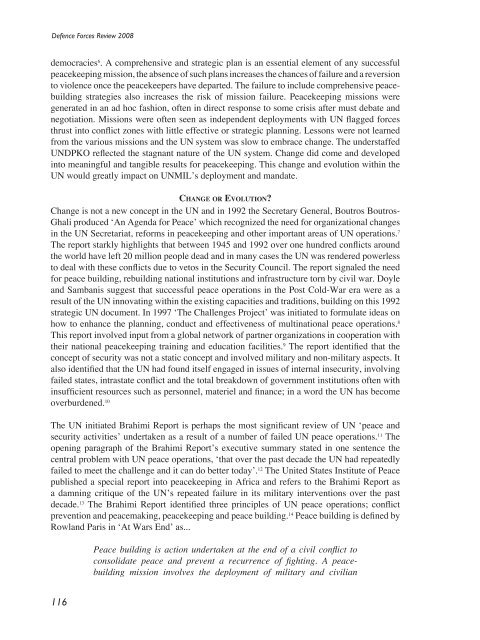Defence Forces Review 2008
Defence Forces Review 2008
Defence Forces Review 2008
You also want an ePaper? Increase the reach of your titles
YUMPU automatically turns print PDFs into web optimized ePapers that Google loves.
<strong>Defence</strong> <strong>Forces</strong> <strong>Review</strong> <strong>2008</strong><br />
democracies 6 . A comprehensive and strategic plan is an essential element of any successful<br />
peacekeeping mission, the absence of such plans increases the chances of failure and a reversion<br />
to violence once the peacekeepers have departed. The failure to include comprehensive peacebuilding<br />
strategies also increases the risk of mission failure. Peacekeeping missions were<br />
generated in an ad hoc fashion, often in direct response to some crisis after must debate and<br />
negotiation. Missions were often seen as independent deployments with UN flagged forces<br />
thrust into conflict zones with little effective or strategic planning. Lessons were not learned<br />
from the various missions and the UN system was slow to embrace change. The understaffed<br />
UNDPKO reflected the stagnant nature of the UN system. Change did come and developed<br />
into meaningful and tangible results for peacekeeping. This change and evolution within the<br />
UN would greatly impact on UNMIL’s deployment and mandate.<br />
Ch a n g e o r Ev o l u t i o n<br />
Change is not a new concept in the UN and in 1992 the Secretary General, Boutros Boutros-<br />
Ghali produced ‘An Agenda for Peace’ which recognized the need for organizational changes<br />
in the UN Secretariat, reforms in peacekeeping and other important areas of UN operations. 7<br />
The report starkly highlights that between 1945 and 1992 over one hundred conflicts around<br />
the world have left 20 million people dead and in many cases the UN was rendered powerless<br />
to deal with these conflicts due to vetos in the Security Council. The report signaled the need<br />
for peace building, rebuilding national institutions and infrastructure torn by civil war. Doyle<br />
and Sambanis suggest that successful peace operations in the Post Cold-War era were as a<br />
result of the UN innovating within the existing capacities and traditions, building on this 1992<br />
strategic UN document. In 1997 ‘The Challenges Project’ was initiated to formulate ideas on<br />
how to enhance the planning, conduct and effectiveness of multinational peace operations. 8<br />
This report involved input from a global network of partner organizations in cooperation with<br />
their national peacekeeping training and education facilities. 9 The report identified that the<br />
concept of security was not a static concept and involved military and non-military aspects. It<br />
also identified that the UN had found itself engaged in issues of internal insecurity, involving<br />
failed states, intrastate conflict and the total breakdown of government institutions often with<br />
insufficient resources such as personnel, materiel and finance; in a word the UN has become<br />
overburdened. 10<br />
The UN initiated Brahimi Report is perhaps the most significant review of UN ‘peace and<br />
security activities’ undertaken as a result of a number of failed UN peace operations. 11 The<br />
opening paragraph of the Brahimi Report’s executive summary stated in one sentence the<br />
central problem with UN peace operations, ‘that over the past decade the UN had repeatedly<br />
failed to meet the challenge and it can do better today’. 12 The United States Institute of Peace<br />
published a special report into peacekeeping in Africa and refers to the Brahimi Report as<br />
a damning critique of the UN’s repeated failure in its military interventions over the past<br />
decade. 13 The Brahimi Report identified three principles of UN peace operations; conflict<br />
prevention and peacemaking, peacekeeping and peace building. 14 Peace building is defined by<br />
Rowland Paris in ‘At Wars End’ as...<br />
Peace building is action undertaken at the end of a civil conflict to<br />
consolidate peace and prevent a recurrence of fighting. A peacebuilding<br />
mission involves the deployment of military and civilian<br />
116
















